HCC-derived exosomes elicit HCC progression and recurrence by epithelial-mesenchymal transition through MAPK/ERK signalling pathway
- PMID: 29725020
- PMCID: PMC5938707
- DOI: 10.1038/s41419-018-0534-9
HCC-derived exosomes elicit HCC progression and recurrence by epithelial-mesenchymal transition through MAPK/ERK signalling pathway
Abstract
Liver cancer is the second most common cause of cancer-related death worldwide. Approximately 70-90% of primary liver cancers are hepatocellular carcinoma (HCC). Currently, HCC patient prognosis is unsatisfactory due to high metastasis and/or post-surgical recurrence rates. Therefore, new therapeutic methods for inhibiting metastasis and recurrence are urgently needed. Exosomes are small lipid-bilayer vesicles that are implicated in tumour development and metastasis. Rab27a, a small GTPase, regulates exosome secretion by mediating multivesicular endosome docking at the plasma membrane. However, whether Rab27a participates in HCC cell-derived exosome exocytosis is unclear. Epithelial-mesenchymal transition (EMT) frequently initiates metastasis. The role of HCC cell-derived exosomes in EMT remains unknown. We found that exosomes from highly metastatic MHCC97H cells could communicate with low metastatic HCC cells, increasing their migration, chemotaxis and invasion. Rab27a knockdown inhibited MHCC97H-derived exosome secretion, which consequently promoted migration, chemotaxis and invasion in parental MHCC97H cells. Mechanistic studies showed that the biological alterations in HCC cells treated with MHCC97H-derived exosomes or MHCC97H cells with reduced self-derived exosome secretion were caused by inducing EMT via MAPK/ERK signalling. Animal experiments indicated that exosome secretion blockade was associated with enhanced lung and intrahepatic metastasis of parental MHCC97H cells, while ectopic overexpression of Rab27a in MHCC97H cells could rescue this enhancement of metastasis in vivo. Injection of MHCC97H cell-derived exosomes through the tail vein promoted intrahepatic recurrence of HLE tumours in vivo. Clinically, Rab27a was positively associated with serum alpha-fetoprotein (AFP) level, vascular invasion and liver cirrhosis. Our study elucidated the role of exosomes in HCC metastasis and recurrence, suggesting that they are promising therapeutic and prognostic targets for HCC patients.
Conflict of interest statement
The authors declare that they have no conflict of interest.
Figures
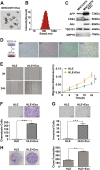
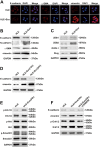
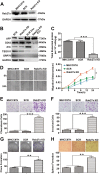
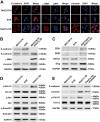
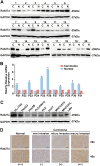
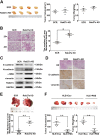
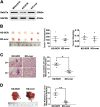
Similar articles
-
Exosome-mediated secretion of LOXL4 promotes hepatocellular carcinoma cell invasion and metastasis.Mol Cancer. 2019 Jan 31;18(1):18. doi: 10.1186/s12943-019-0948-8. Mol Cancer. 2019. PMID: 30704479 Free PMC article.
-
Serum exosomal miR-638 is a prognostic marker of HCC via downregulation of VE-cadherin and ZO-1 of endothelial cells.Cancer Sci. 2021 Mar;112(3):1275-1288. doi: 10.1111/cas.14807. Epub 2021 Jan 29. Cancer Sci. 2021. PMID: 33426736 Free PMC article.
-
Overexpression of the long non-coding RNA SPRY4-IT1 promotes tumor cell proliferation and invasion by activating EZH2 in hepatocellular carcinoma.Biomed Pharmacother. 2017 Jan;85:348-354. doi: 10.1016/j.biopha.2016.11.035. Epub 2016 Nov 28. Biomed Pharmacother. 2017. PMID: 27899259
-
The role of extracellular vesicles in mediating progression, metastasis and potential treatment of hepatocellular carcinoma.Oncotarget. 2017 Jan 10;8(2):3683-3695. doi: 10.18632/oncotarget.12465. Oncotarget. 2017. PMID: 27713136 Free PMC article. Review.
-
Recent progress in the emerging role of exosome in hepatocellular carcinoma.Cell Prolif. 2019 Mar;52(2):e12541. doi: 10.1111/cpr.12541. Epub 2018 Nov 5. Cell Prolif. 2019. PMID: 30397975 Free PMC article. Review.
Cited by
-
Trimethylamine N-oxide promotes the proliferation and migration of hepatocellular carcinoma cell through the MAPK pathway.Discov Oncol. 2024 Aug 12;15(1):346. doi: 10.1007/s12672-024-01178-8. Discov Oncol. 2024. PMID: 39133354 Free PMC article.
-
SSPH I, A Novel Anti-cancer Saponin, Inhibits EMT and Invasion and Migration of NSCLC by Suppressing MAPK/ERK1/2 and PI3K/AKT/ mTOR Signaling Pathways.Recent Pat Anticancer Drug Discov. 2024;19(4):543-555. doi: 10.2174/0115748928283132240103073039. Recent Pat Anticancer Drug Discov. 2024. PMID: 38305308
-
Emerging roles and therapeutic value of exosomes in cancer metastasis.Mol Cancer. 2019 Mar 30;18(1):53. doi: 10.1186/s12943-019-0964-8. Mol Cancer. 2019. PMID: 30925925 Free PMC article. Review.
-
Hypoxia-inducible gene 2 promotes the immune escape of hepatocellular carcinoma from nature killer cells through the interleukin-10-STAT3 signaling pathway.J Exp Clin Cancer Res. 2019 May 29;38(1):229. doi: 10.1186/s13046-019-1233-9. J Exp Clin Cancer Res. 2019. PMID: 31142329 Free PMC article.
-
Exosomes: key players in cancer and potential therapeutic strategy.Signal Transduct Target Ther. 2020 Aug 5;5(1):145. doi: 10.1038/s41392-020-00261-0. Signal Transduct Target Ther. 2020. PMID: 32759948 Free PMC article. Review.
References
-
- Torre LA, et al. Global cancer statistics, 2012. CA: Cancer J. Clin. 2015;65:87–108. - PubMed
Publication types
MeSH terms
Substances
LinkOut - more resources
Full Text Sources
Other Literature Sources
Medical
Research Materials
Miscellaneous

